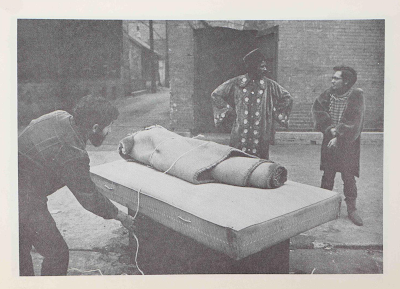Tracey Emin
Strangeland
London, UK: Sceptre, 2005
213 pp., 20.5 x 13.5 cm., hardcover
Edition size unknown
Tracey Emin's most celebrated and controversial work Everyone I Have Ever Slept With 1963–1995 consisted of a tent with the appliquéd names of everyone she had ever shared a bed with. She described the piece as about "abortion, rape, teenage sex, abuse and poverty".
Three years later My Bed was inspired by a depressive time in Emin's life when she remained in bed for four days without eating or drinking anything but alcohol.
Given the overt and autobiographical nature of these work, a tell-all memoir was inevitable.
In Strangeland, she candidly and matter-of-factly writes about her abortions (the second was “revenge for the first”), her eating disorders (“I had no tits, no hips, and I only ate digestive biscuits”), and her back alley rape by a classmate when she was thirteen (“I was crying. His lips were pressed against mine but I was motionless, like a small corpse.”).
She quit school that year, and left the small seaside town of Margate two years after that.
The book offers an account of the artist's journey to becoming "a fucked, crazy, anorexic-alcoholic-childless, beautiful woman” - from departing for London with twenty pounds and a pair of David Bowie LPs, to laying poolside and receiving calls about a Turner Prize nomination, the Pulp song about her hitting number one on the charts, and Bowie himself offering a flight home on his private jet.
The passages that Julian Schnabel cites below are about Emin shoving a classmate into a tree and another - repeatedly - into a wall until “blood squirted everywhere”, all because one of them called Emin’s mother “old”; stealing from a drug dealer because he was "shit in bed”; and losing a dance competition because several boys she had slept with began chanting “Slag, Slag, Slag” at her. All before she was fourteen.
Some of the most interesting stories in the book are about her Turkish father, constantly trying to regale his bored daughter with tales of his homeland:
“Yes, Dad, I know all about my grandmother and how she tore off her yashmak in front of the whole village because she wasn’t allowed to marry my granddad.”
“No, Dad. But you told me how Queen Victoria earned the island of Cyprus. She spent one night at the Sultan’s palace and the next morning she left with the deeds of Cyprus.”
""Like a fucking dog when the truth is hard to bear; I waved goodbye to my mum at the school gates.” I've read these words aloud on more than one occasion. This is the title of a story from Tracey Emin's book Strangeland. At the time, I wanted to share it with everybody I met. I don't know the exact date of when it was written. I'm under the impression that it was written as a diary entry by the teenage Tracey. I wouldn't be surprised if it was written yesterday. I was so impressed by this book that I'd like to recommend it as required reading for young people everywhere; the loneliness, the fragility, the disappointment and honesty, the clarity of all of it.
Suggested reading: "Like a fucking dog when the truth is hard to bear"; "Nayland Rock"; "Why I never became a dancer" – Hades, read the whole book for God's sake. She's a teenage Charles Bukowski, a Sam Shepard, giving Margate the distinction that Marty Scorsese gives to Little Italy. The cradle and site of adolescent crimes, unconscious acts, and brutal truths that form who we are and the scenes that made Tracey an artist.”
- Julian Schnabel



































































